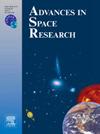Contractional strains and maximum displacement-length ratios of lunar wrinkle ridges in four Maria of basalt
IF 2.8
3区 地球科学
Q2 ASTRONOMY & ASTROPHYSICS
引用次数: 0
Abstract
Compressional stresses from the basalt basins on the lunar are responsible for the formation of wrinkle ridges in lunar mare basalts. According to the wide angle multispectral camera (WAC) mosaic image, we selected 62, 75, 73, and 58 single wrinkle ridges in Mare Imbrium, Mare Serenitatis, Mare Fecunditatis, and Mare Tranquillitatis, respectively, for this paper. Several topographic profiles near the midpoint of each wrinkle ridge are generated to measure the maximum displacement () and height of the wrinkle ridges using digital elevation model (LOLA) data. After that, we create 2D plots of displacement-length () for the ridge population in the four Maria and compare the results. A linear fit method derives the ratios (γ) from the D-L data. We calculated the contractional strains in each mare area based on the cap D sub m a. x over cap L data. Moreover, each mare's gravity pattern, mare thickness, and formation age are also presented. The ridges in Mare Imbrium and Mare Serenitatis have a higher γ value (1.83 × 10−2 and 1.98 × 10−2) than the ridges in Mare Fecunditatis and Mare Tranquillitatis, which have γ values of (1.67 × 10−2 and 1.75 × 10−2). Finally, the contractional strains (ε) in Mare Imbrium, Mare Serenitatis, Mare Fecunditatis, and Mare Tranquillitatis are estimated to be 0.23 %, 0.41 %, 0.39 %, and 0.18 % (considering 25° is the fault plane dip θ), respectively. The maximum values of the free-air gravity anomalies in Mare Fecunditatis range from −30 to 250 mGal, while minimum gravity anomalies in Mare Serenitatis range from −80 to 140 mGal. Mare Imbrium, Mare Serenitatis, Mare Fecunditatis, and Mare Tranquillitatis have an average thickness of 300 m, 910 m, 652 m, and 760 m, respectively. Furthermore, the Mare Imbrium ridge group is older than the Lunar Wrinkle Ridges in Mare Serenitatis. Mare Tranquillitatis ridge group formation takes longer than Mare Imbrium ridge group formation. Therefore, we believe that it has thicker basaltic units, a longer wrinkle ridge formation time, and higher gravity anomaly than the Mare Imbrium and Mare Serenitatis basins, even though the formation of the Mare Tranquillitatis and Mare Fecunditatis basins occurred earlier.
四种玛利亚玄武岩中月球皱纹脊的收缩应变和最大位移长度比
本文章由计算机程序翻译,如有差异,请以英文原文为准。
求助全文
约1分钟内获得全文
求助全文
来源期刊

Advances in Space Research
地学天文-地球科学综合
CiteScore
5.20
自引率
11.50%
发文量
800
审稿时长
5.8 months
期刊介绍:
The COSPAR publication Advances in Space Research (ASR) is an open journal covering all areas of space research including: space studies of the Earth''s surface, meteorology, climate, the Earth-Moon system, planets and small bodies of the solar system, upper atmospheres, ionospheres and magnetospheres of the Earth and planets including reference atmospheres, space plasmas in the solar system, astrophysics from space, materials sciences in space, fundamental physics in space, space debris, space weather, Earth observations of space phenomena, etc.
NB: Please note that manuscripts related to life sciences as related to space are no more accepted for submission to Advances in Space Research. Such manuscripts should now be submitted to the new COSPAR Journal Life Sciences in Space Research (LSSR).
All submissions are reviewed by two scientists in the field. COSPAR is an interdisciplinary scientific organization concerned with the progress of space research on an international scale. Operating under the rules of ICSU, COSPAR ignores political considerations and considers all questions solely from the scientific viewpoint.
 求助内容:
求助内容: 应助结果提醒方式:
应助结果提醒方式:


